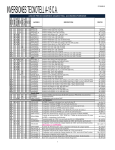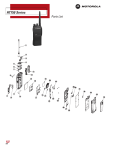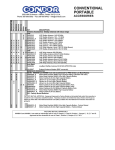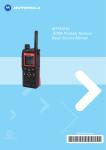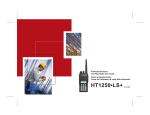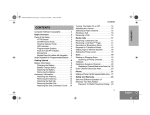Download Motorola PR860 User guide
Transcript
PR860 Portable Radio User Guide 6881098C02-O Contents CONTENTS Safety . . . . . . . . . . . . . . . . . . . . . . . . . . . . . 3 Product Safety and RF Exposure Compliance . . . . . . . . . . . . . . . . . 3 Radio Overview . . . . . . . . . . . . . . . . . . . . . 4 Parts of the Radio . . . . . . . . . . . . . . . . . . . . 4 PR860 Model . . . . . . . . . . . . . . . . . . . . . 4 On/Off/Volume Knob . . . . . . . . . . . . . . . 5 Channel Selector Knob . . . . . . . . . . . . . 5 LED Indicator . . . . . . . . . . . . . . . . . . . . . 5 Programmable Buttons . . . . . . . . . . . . . 5 Push-to-Talk (PTT) Button . . . . . . . . . . . 7 Microphone . . . . . . . . . . . . . . . . . . . . . . 7 Audio Indicators for Programmable Buttons . . . . . . . . . . . . . . . . 7 Getting Started . . . . . . . . . . . . . . . . . . . . . 8 Battery Information . . . . . . . . . . . . . . . . . . . 8 Charging the Battery . . . . . . . . . . . . . . . 8 Battery Charge Status . . . . . . . . . . . . . . 9 Attaching the Battery . . . . . . . . . . . . . . 10 Removing the Battery . . . . . . . . . . . . . 10 11 11 11 12 12 13 13 14 14 14 14 Radio Calls . . . . . . . . . . . . . . . . . . . . . . . Receiving a Selective Call . . . . . . . . . . . . Receiving a Call Alert™ Page . . . . . . . . . Sounding an Emergency Siren. . . . . . . . . Repeater or Talkaround Mode . . . . . . . . . Setting Tight or Normal Squelch. . . . . . . . Setting the Power Level . . . . . . . . . . . . . . 15 15 15 15 15 16 16 Scan . . . . . . . . . . . . . . . . . . . . . . . . . . . . . Starting or Stopping Scan. . . . . . . . . . . . . Scanning a Priority Channel . . . . . . . . Talkback . . . . . . . . . . . . . . . . . . . . . . . . . . Deleting a Nuisance Channel . . . . . . . . . . Restoring a Channel Back to the Scan List . . . . . . . . . . . . . . . . . . 17 17 17 17 18 CONTENTS Computer Software Copyrights . . . . . . . . . . 2 Accessory Information . . . . . . . . . . . . . . . Attaching the Antenna . . . . . . . . . . . . . Removing the Antenna . . . . . . . . . . . . Attaching the Belt Clip . . . . . . . . . . . . . Removing the Belt Clip . . . . . . . . . . . . Attaching the Side Connector Cover . . Turning The Radio On or Off . . . . . . . . . . Adjusting the Volume . . . . . . . . . . . . . . . . Selecting a Radio Channel . . . . . . . . . . . . Sending a Call . . . . . . . . . . . . . . . . . . . . . Receiving a Call . . . . . . . . . . . . . . . . . . . . 18 1 English Contents CONTENTS Scan Channel Discovery Alert . . . . . . . . . 18 Accessories . . . . . . . . . . . . . . . . . . . . . . Carry Accessories. . . . . . . . . . . . . . . . . . . Chargers . . . . . . . . . . . . . . . . . . . . . . . . . . Headsets . . . . . . . . . . . . . . . . . . . . . . . . . Surveillance . . . . . . . . . . . . . . . . . . . . . . . Remote Speaker Microphones . . . . . . . . . Adapters . . . . . . . . . . . . . . . . . . . . . . . . . . Batteries . . . . . . . . . . . . . . . . . . . . . . . . . . Antennas . . . . . . . . . . . . . . . . . . . . . . . . . Miscellaneous . . . . . . . . . . . . . . . . . . . . . . 2 English 19 19 19 20 21 22 22 22 23 23 COMPUTER SOFTWARE COPYRIGHTS The Motorola products described in this manual may include copyrighted Motorola computer programs stored in semiconductor memories or other media. Laws in the United States and other countries preserve for Motorola certain exclusive rights for copyrighted computer programs, including, but not limited to, the exclusive right to copy or reproduce in any form the copyrighted computer program. Accordingly, any copyrighted Motorola computer programs contained in the Motorola products described in this manual may not be copied, reproduced, modified, reverse-engineered, or distributed in any manner without the express written permission of Motorola. Furthermore, the purchase of Motorola products shall not be deemed to grant either directly or by implication, estoppel, or otherwise, any license under the copyrights, patents or patent applications of Motorola, except for the normal non-exclusive license to use that arises by operation of law in the sale of a product. Safety SAFETY PRODUCT SAFETY AND RF EXPOSURE COMPLIANCE ! Caution For a list of Motorola-approved antennas, batteries, and other accessories, visit the following web site which lists approved accessories: http://www.motorola.com/cgiss/ index.shtml. Before using this product, read the operating instructions for safe usage contained in the Product Safety and RF Exposure booklet enclosed with your radio. ATTENTION! SAFETY This radio is restricted to occupational use only to satisfy FCC RF energy exposure requirements. Before using this product, read the RF energy awareness information and operating instructions in the Product Safety and RF Exposure booklet enclosed with your radio (Motorola Publication part number 68P81095C98) to ensure compliance with RF energy exposure limits. 3 English Radio Overview RADIO OVERVIEW PARTS OF THE RADIO PR860 Model RADIO OVERVIEW Channel Selector Knob Top Button (TB) (programmable) On/Off/Volume Knob LED Indicator Side Button 1 (A) (programmable) Push-to-Talk (PTT) Button Microphone Side Button 2 (B) (programmable) Side Button 3 (C) (programmable) 4 English Side Connector Cover Radio Overview On/Off/Volume Knob Turns the radio on or off, and adjusts the radio’s volume. Channel Selector Knob Switches the radio to different channels. Each button can access up to two features, depending on the type of button press: short press—quickly pressing and releasing the programmable buttons, or • long press—pressing and holding the programmable buttons for at least 1 1/2 seconds, or • hold down—pressing and holding down the programmable buttons while checking status or making adjustments. LED Indicator Indicates status of battery, power-up, scanning, and receipt of a selective call. Programmable Buttons Several of your radio’s buttons can be programmed by your dealer as shortcut buttons for many of the radio’s features. Check with your dealer for a complete list of functions your radio supports. Programmable buttons include: • The three Side Buttons (A, B, C) and the Top Button (D) The table on page 6 summarizes the programmable features available and shows the page number where the feature is explained. In the “Button” column, have your dealer write down the programmable buttons next to the features that have been programmed to them. RADIO OVERVIEW • Use the abbreviations (e.g., A for Side Button 1, D for Top Button, etc.) shown in the radio illustration at the front of this manual. Also, where a choice exists, have your dealer indicate whether the button press is short press (SP) or long press (LP). 5 English Radio Overview RADIO OVERVIEW Function Long Press Hold Down Cancel Emergency Siren. — 15 — — Emergency (Top button only) Initiate Emergency Siren. Monitor Turn monitor function Continually monitor off. selected channel. Page Button Volume Set — — Sound a tone for adjusting your radio’s volume level. Battery Gauge — — Check the battery’s charge status. 9 — 18 Toggle scan on and off. Power level Toggle transmit power level between High and Low.† — 16 Repeater/ Talkaround Toggle between using a repeater or transmitting directly to another radio.† — 15 Squelch Toggle squelch level between Tight and Normal.† — 16 Option Board (if one is installed) Toggle between activating and deactivating the option board.† — — Radio Call Make a radio call.† — 15 6 Delete a nuisance channel while scanning. 14 Scan/Nuisance Channel Delete † English Short Press This function is activated by EITHER a short press OR a long press, but not both. Radio Overview Push-to-Talk (PTT) Button Press and hold down this button to talk; release it to listen. AUDIO INDICATORS FOR PROGRAMMABLE BUTTONS High-Low Tone Microphone When sending a message, hold the microphone 1 to 2 inches (2.5 to 5 cm) away from your mouth, and speak clearly into the microphone. Low-High Tone Some programmable buttons use tones to indicate one of two modes: High-Low Tone Low-High Tone Scan Start scan Stop scan Power Level Low power selected High power selected Squelch Tight squelch Normal squelch Option Board Activated Deactivated Repeater/ Talkaround Does not use repeater Uses repeater RADIO OVERVIEW Button 7 English Getting Started GETTING STARTED BATTERY INFORMATION Charging the Battery If a battery is new, or its charge level is very low, you will need to charge it before you can use it. GETTING STARTED Note: Batteries are shipped uncharged from the factory. Always charge a new battery 14 to 16 hours before initial use, regardless of the status indicated by the charger. 8 English To charge the battery: Place the battery, with or without the radio, in the charger. The charger LED indicates the charging progress: LED color Status No LED Indication Battery inserted incorrectly. Single Green Flash Successful charger power-up. Flashing Red* Battery unchargeable or not making proper contact. Steady Red Battery in rapid-charge mode. Flashing Yellow Battery in charger, not in rapid-charge mode but waiting to be charged. Getting Started LED color Status Flashing Green† Battery 90% (or more) charged. Steady Green Battery fully charged. * Remove the battery from the charger and use a pencil eraser to clean the four metal contacts on the bottom of the battery. Place the battery back in the charger. If the LED indicator continues to flash red, replace the battery. † A standard battery may require one hour to charge to 90%. Battery Charge Status You can check battery charge status by holding down the preprogrammed Battery Gauge button (see page 6). The charge status is shown by the color of the radio’s LED indicator. Battery Level LED Indicator High Green Sufficient Yellow Low Blinking red Very Low None Battery chargers only charge the Motorolaauthorized batteries listed at Chargers on page 19; other batteries may not charge. GETTING STARTED 9 English Getting Started Attaching the Battery Removing the Battery Battery Latches 2 2 3 GETTING STARTED 1 1 Fit the extensions at the bottom of the battery into the bottom slots on the radio. 2 Press the top part of the battery toward the radio until you hear a click. 10 English 1 Turn off the radio (see page 13). 2 Slide both battery latches downward. 3 Pull the top part of the battery away from the radio. Getting Started ACCESSORY INFORMATION Attaching the Antenna Turn the antenna counterclockwise to remove it. GETTING STARTED Turn the antenna clockwise to attach it. Removing the Antenna 11 English Getting Started Attaching the Belt Clip Removing the Belt Clip Belt Clip Tab 1 GETTING STARTED 2 1 Align the grooves of the belt clip with those of the battery. 1 Use a key to press the belt clip tab away from the battery. 2 Press the belt clip downward until you hear a click. 2 Slide the belt clip upward to remove it. 12 English Getting Started Attaching the Side Connector Cover TURNING THE RADIO ON OR OFF Antenna Loop Slot Thumbscrew ON 1 Place the loop (attached to the side connector cover) over the antenna; then slide it downward until it touches the top of the radio. Insert the tab on the top of the cover into the slot above the connector. 3 Position the cover over the connector and align the thumbscrew with the threaded hole in the radio. 4 Tighten the thumbscrew to hold the cover in place. Do not overtighten the thumbscrew. If power-up is successful, you will hear the Self-Test Pass Tone Turn the On/Off/ Volume Control knob counterclockwise until you hear a click. GETTING STARTED 2 Turn the On/Off/ Volume Control knob clockwise. OFF and see the LED turn green. If the radio fails to power up, you will hear the Self-Test Fail Tone . 13 English Getting Started ADJUSTING THE VOLUME 1 2 3 SENDING A CALL Hold down the Volume Set or Monitor button (see page 6); you will hear a continuous 1 Turn your radio on. tone. 2 Use the Channel Selector knob to select the desired channel. Turn the On/Off/Volume Control knob to the desired volume level. 3 Hold the radio in a vertical position, press the PTT button, and talk at a distance of about 1 to 2 inches (2.5 to 5 cm) from the microphone. 4 Release the PTT button to listen. Release the Volume Set or Monitor button. SELECTING A RADIO CHANNEL Your radio offers either 4 or 16 channels. GETTING STARTED Note: Due to government regulations, some channels may not be programmed. Ask your dealer for more information. To select a channel, turn the Channel Selector knob clockwise or counterclockwise until you reach the desired channel. 14 English RECEIVING A CALL 1 Turn your radio on. 2 Adjust the radio’s volume (see page 14). 3 Switch to the desired channel. 4 If at any time a call comes through, you will hear the call at the volume level you have set. Radio Calls RADIO CALLS When you receive a selective call: • You will hear two alert tones. • The LED Indicator will light yellow. To answer the call, press the PTT button. RECEIVING A CALL ALERT™ PAGE (16-channel models only) When your radio receives a Call Alert page, it sounds four alert tones continuously until you respond. Press the PTT button to answer the Call Alert page, or press any other key to cancel it. Note: Your radio will not receive any Selective Calls until you clear the page. When the orange Top button is pressed, your radio will sound a loud, piercing Emergency Siren (see page 6), if programmed by your dealer (see page 5). To stop the Emergency Siren, press the Emergency button again. RADIO CALLS RECEIVING A SELECTIVE CALL (16-channel models only) SOUNDING AN EMERGENCY SIREN REPEATER OR TALKAROUND MODE Talkaround Mode enables you to communicate with another radio when either: • the repeater is not operating –or– • your radio is out of the repeater’s range but within communicating distance of another radio. Press the preprogrammed Repeater/ Talkaround button (see page 6) to toggle between Repeater Mode and Talkaround Mode. 15 English RADIO CALLS Radio Calls SETTING TIGHT OR NORMAL SQUELCH Use this feature to filter out nuisance (unwanted) calls and/or background noise. However, tightening squelch could cause calls from remote locations to be filtered out as well. In this case, normal squelch may be more desirable. Press the preprogrammed Squelch button (see page 6) to toggle between tight and normal squelch. SETTING THE POWER LEVEL Each channel in your radio has a predefined transmit power level that can be changed: • High power allows you to reach a radio that is farther away. • Low power conserves the battery’s charge. • Auto power automatically sets the optimal power level based on the strength of the signal received. If the received signal is weak, the transmit level will be set to high, and vice-versa. Note: Be aware that a message received from a nearby radio might change your radio’s power level to low. This may cause radios that are farther away not to receive your transmissions. Press the preprogrammed Power Level button (see page 6) to toggle between low and high power. 16 English Scan SCAN You can monitor multiple channels and receive any calls that are transmitted on them. Depending on your radio model, either four or sixteen different channels can be programmed into each scan list by the dealer. Your radio will automatically switch to a scan list channel when it detects activity on it. Priority Channel Scanning Sequence None specified Ch1➠Ch2➠Ch3➠ Ch4➠…Ch1 Channel 2 Ch2➠Ch1➠Ch2➠Ch3➠ Ch2➠Ch4➠Ch2➠…Ch1 STARTING OR STOPPING SCAN TALKBACK The LED indicator blinks green during a scan operation, and stops blinking when the radio switches to a channel. While your radio is scanning, Talkback allows you to participate in a call in progress. You must press the PTT button to participate in the call; otherwise, scanning continues to the next channel. To start or stop a scanning, press the preprogrammed Scan button (see page 6). SCAN Note: The same channels can be assigned to different scan lists. Note: Even if there is activity on a non-priority channel, your radio will automatically switch to an active priority channel, and indicate the activity with a short tone. Scanning a Priority Channel You may want to check the activity on one channel more frequently than others. Your dealer is able to prioritize channels for you. For example: 17 English SCAN Scan DELETING A NUISANCE CHANNEL SCAN CHANNEL DISCOVERY ALERT If a channel continually generates unwanted calls or noise (a “nuisance” channel), use the Scan button to temporarily delete the channel from the scan list: This feature enables you to identify the last channel monitored before scanning was stopped. To identify the last channel monitored, turn the Channel Selector knob until you hear an alert tone. 1 While the radio is on the nuisance channel, hold down the Scan button until you hear a tone. 2 Release the Scan button. The nuisance channel is deleted. Note:You cannot delete a priority channel or the last remaining channel in a scan list. Restoring a Channel Back to the Scan List To restore a previously deleted channel back to the scan list, restart the scan operation or turn your radio off and on again. 18 English Accessories ACCESSORIES Motorola offers a number of accessories to enhance the productivity of your two-way radio. Many of the available accessories are listed below. For a complete list, see your Motorola dealer. CARRY ACCESSORIES 2 1/2” Spring Action Belt Clip Portable Radio Hanger (for door panels from 2.75” to 3.25”) HLN9985 Waterproof Bag NTN5243 Shoulder Strap CHARGERS WPLN4182 impresTM 120 Volt Single-Unit Charger WPLN4187 impresTM 120 Volt Multi-Unit Charger WPLN4192 impresTM 120 Volt Multi-Unit Charger with Display AAHTN3000 120 Volt Single-Unit Rapid Rate Intelli-Charger AAHTN3003 120 Volt 6 Unit Rapid Rate Intelli-Charger HLN9844 2” Spring Action Belt Clip HLN9952 Carry Holder Belt Clip HLN9652 Leather Case with Belt Loop, Li-Ion HLN9665 Leather Case with Belt Loop, NiMH & NiCd NLN7967 Wall Mount Kit for Multi-Unit Charger HLN9670 Leather Case with Swivel, Li-Ion WPLN4124_R Battery Optimizing System II (BOS II) HLN9676 Leather Case with Swivel, NiMH & NiCd RL-76345 HLN9701 Nylon Case with Belt Loop Battery Optimizing System (BOS II) Adapter Plate NTN8039 2.5" High Activity Swivel Belt Loop RLN5233 Hard Wire Vehicular Charger NTN8040 3" High Activity Swivel Belt Loop RLN4883 Travel Charger HLN6602 Universal Chest Pack NDN4005 Battery Maintenance System Plus (BMSPLUS), Three Station RLN4815 RadioPAk Radio/Utility Case WPLN4079_R TDN9327 Portable Radio Hanger (for door panels up to 2.75”) Battery Maintenance System Plus (BMSPLUS), Six Station ACCESSORIES HLN9714 TDN9373 19 English Accessories ACCESSORIES WPLN4107_R Motorola Conditioning Charger (MCC) Singe-Unit with Adapter Plate Ultra-Light Headset, Behind the Head AARMN4017 Ultra-Light Headset, Earbud Style Receiver WPPN4065_R Motorola Conditioning Charger (MCC) Four Station RMN4048 Temple Transducer WPPN4082_R Adapter Plate Only (use with MCC) RMN5048 Rugged Temple Transducer RLN4814 Vehicular Mounting Bracket For Single Unit MCC ENMN4016 Medium Duty Headset, Behind the Head WPPN4079_R BMS Battery Adapter (for use with NiCd & NiMH batteries) AARMN4019 WPPN4080_R BMS Battery Adapter (for use with NiCd, NiMH & Li-Ion Batteries) Medium Weight Over-the-Head Headset with Noise Cancelling Mic & Inline PTT AARMN4032 Medium Weight Over-the-Head Headset with Noise Cancelling Mic RMN5047 NFL Style Heavy Duty Headset (requires AAHLN9716 Adapter) RMN5015 Racing Headset (RKN4091 adapter cable required) VEHICULAR ADAPTERS AND ACCESSORIES AAEN1006 Vehicular Adapter - VHF AAEN1007 Vehicular Adapter - UHF AARMN4020 ENKN4002 Programming Cable for VHF and UHF Vehicular Adapters Push-to-Talk or VOX Heavy Duty Headset RMN4051 GKN6270 Power Cable with 10A Fuse 2-Way Hard-Hat Mount Headset, Black (requires RKN4097 adapter cable) GSN6059 13 W External Speaker RMN4052 Tactical Headband Style Headset, Gray (requires RKN4097 adapter cable) RMN4053 Tactical Hard-Hat Mount Headset, Gray (requires RKN4097 adapter cable) RMN4054 Receive Only Hard-Hat Mount Headset RMN4055 Receive Only Headband Style Headset HEADSETS AARMN4018 Lightweight Single Muff Headset with Swivel Boom Mic & Inline PTT AARMN4031 Lightweight Single Muff Adjustable Headset with Swivel Boom Mic 20 English ENMN4012 Accessories ADAPTERS AND CABLES AAHLN9716 Adapter for Audio Accessories RKN4097 In-Line PTT Adapter Cable RKN4091 Adapter Cable (for use with RMN5015) SURVEILLANCE AARMN4021 Receive Only Earpiece, 1-wire, Beige CommPort Integrated Ear Microphone/Receiver System with PTT on Radio Adapter NTN1723 Integrated Ear Microphone/Receiver System with Palm PTT NTN1724 Integrated Ear Microphone/Receiver System with Ring PTT NTN1737 Integrated Ear Microphone/Receiver System with Snap-on-Side PTT NNTN4187 Integrated Ear Microphone/Receiver System with Body PTT AARMN4028 Receive Only Earpiece, 1-wire, Black AARMN4022 Earpiece with Microphone and Push-toTalk Combined, 2-Wire, Beige AARMN4029 Earpiece with Microphone and Push-toTalk Combined, 2-Wire, Black ENMN4017 Earpiece with Microphone and Push-toTalk Combined, 3-Wire, Beige BDN6677 Ear Microphone for Standard Noise Levels, Black ENMN4014 Earpiece with Microphone and Push-toTalk Combined, 3-Wire, Black BDN6678 Ear Microphone for Standard Noise Levels, Beige NTN8370 Extreme Noise Kit BDN6641 NTN8371 Low Noise Kit Ear Microphone for High Noise Levels, Gray RLN5316 Comfort Earpiece with Microphone and PTT Combined, 2-Wire, Beige RLN5315 Comfort Earpiece with Microphone and PTT Combined, 2-Wire, Black RLN4922 Completely Discreet Earpiece Kit ENMN4013 Flexible Ear Receiver EAR MICROPHONE SYSTEM AARMN404 4 Push-to-Talk Only Interface Module AARMN404 5 Push-to-Talk or Voice Activated Interface Module 0180358B38 Push-to-Talk Ring Switch 0180300E83 Push-to-Talk Body Switch 0180300E25 Earguard with Adjustable Loop ACCESSORIES NTN1722 21 English Accessories ACCESSORIES MICROPHONES AAHMN9052 Remote Speaker Microphone NAD6502_R VHF 146-174 MHz, Heliflex AAHMN9053 Noise-Cancelling Remote Speaker Microphone PMAD4012 VHF 136-155 MHz 9 cm, Stubby PMAD4025 VHF 150-161 MHz, Stubby AAHMN9054 UHF Public Safety Speaker Microphone AAHMN9057 VHF Public Safety Speaker Microphone RMN5055 Heavy Duty Remote Speaker Microphone BATTERIES HNN4001 impresTM NiMH, 1900 mAH, 7.5 V HNN4002 impresTM NiMH, 1800 mAH, 7.5 V, Intrinsically Safe HNN4003 impresTM Li-Ion, 2000 mAH, 7.5 V HNN9008_R Premium NiMH, 1500 mAH, 7.5 V (not compatible with low band models) HNN9009_R Premium NiMH, 1900 mAH, 7.5 V HNN9010_R Premium NiMH, 1800 mAH, 7.5 V, Intrinsically Safe HNN9011_R Premium NiCd, 1200 mAH, 7.5 V, Intrinsically Safe HNN9012_R Premium NiCd, 1300 mAH, 7.5 V HNN9013_R Premium Li-lon, 1200 mAH, 7.5 V 22 English ANTENNAS PMAD4013 VHF 155-174 MHz 9 cm, Stubby 8504762J01 VHF 136-155 MHz 14 cm, Whip NAD6579 VHF 148-161 MHz, Whip PMAD4023 VHF 150-161 MHz, Whip 8504762J02 VHF 155-174 MHz 14 cm, Whip PMAE4002 UHF 403-433 MHz, Stubby 8504762J08 UHF 433-470 MHz, Stubby NAE6483_R UHF 403-520 MHz, Whip NAB6064 Low Band 30-50 MHz, Heliflex Sending a Call 1. Turn Channel Selector knob to desired channel. 2. Press PTT and speak clearly with mouth about 2.5 to 5 cm (1 to 2 inches) away from microphone. 3. Release PTT to listen. Receiving a Call 1. Turn radio on and set volume level. 2. Switch to desired channel. 3. When a call is received, it will be heard at the volume level you set. PR860™ Quick Reference Card Record the functions for your radio’s programmable buttons in the table provided below. For further information, see page 6 in this User Guide. Channel Selector Knob Top Button (D) (programmable) On/Off/Volume Knob Deleting a Nuisance Channel During Scanning 1. While on a nuisance channel, press and hold preprogrammed Scan button until you hear a tone. 2. Release Scan button. LED Indicator Side Button 1 (A) (programmable) Sounding an Emergency Siren • • Microphone Press preprogrammed Emergency button (Top button [D]) to sound Emergency Siren. Press Emergency button again to stop Emergency Siren. Push-to-Talk (PTT) Button Side Button 2 (B) (programmable) Side Button 3 (C) (programmable) Button Function Short Press Long Press Hold Down Page Motorola, Inc. 8000 West Sunrise Boulevard Ft. Lauderdale, FL 33322 MOTOROLA, and the Stylized M Logo are registered in the U.S. Patent and Trademark Office. All other product or service names are the property of their respective owners. © Motorola, Inc. 2004. All rights reserved. *6881098C02* 6881098C02-O




























